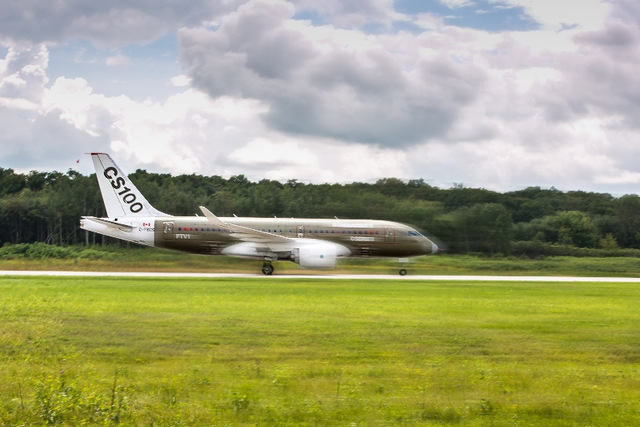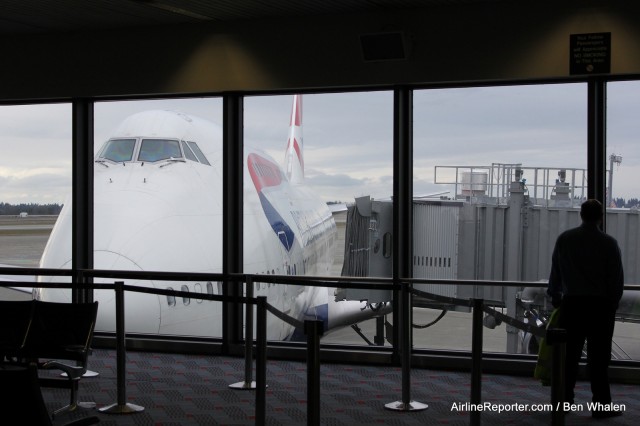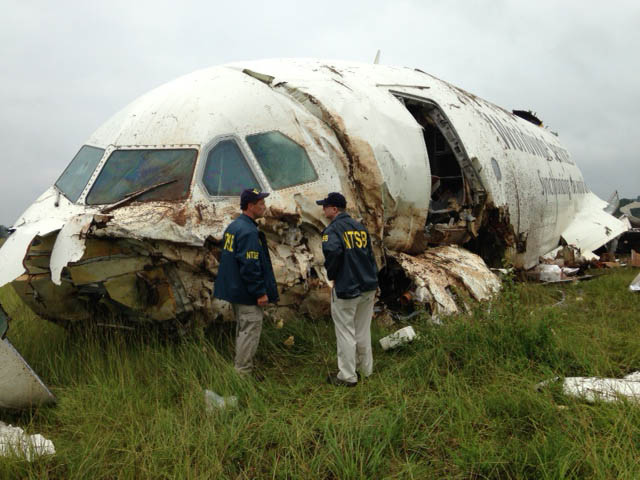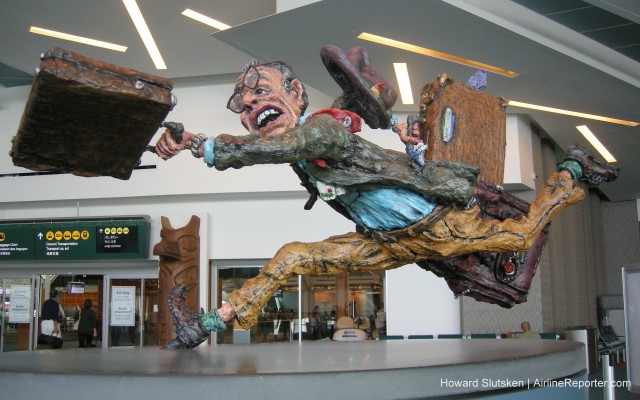For most AvGeeks, this whole video will probably be quite interesting. But to get to the good stuff, try fast forwarding until about the 2:45 mark. Here you are able to watch the experimental Bradley Aerobat BA-100 (reg N27BD) lose power and come to an almost instant stop when crashing into some trees.
The crash occurred on August 10th, shortly after the aircraft took off from Skylark Airfield (ILE) in Killeen, TX. According to the Killeen Daily Herald, the aircraft experience engine failure (which can be heard in the video) and struck a group of trees. The pilot was okay and called 911 for help. It took a while for officials to find the plane and pilot which were stuck 6′ above the ground.
The 56 yr old pilot, Brian Douglas, stated that the crash has not deterred him from flying, but his wife has told him he is not doing any more experimental flying.

Bombardier CS100 FTV1 is rolling!
Photo: Bombardier
Bombardier Commercial Aircraft announced today that CSeries Flight Test Vehicle 1 (FTV1) has started slow-speed taxi tests at Mirabel Airport.
’œWe checked off yet another great series of accomplishments on the first CSeries aircraft. It was thrilling to see FTV1 move under its own power on the tarmac during the low-speed taxi runs this week,” said Robert Dewar, Vice President and General Manager, CSeries Program. He added, “I’m also pleased to share that FTV1 completed the high-powered engine runs while the aircraft was stationary. When full thrust was applied, we were able to run full vibration checks ’“ but most telling, the flight test team was extremely impressed with how quiet the engines were at full power.’
In addition to other final tests, FTV1 will soon head into the paint shop for a new “look”. FTV1’s first flight is still scheduled to take place “in the coming weeks.”
Click HERE to read Bombardier’s press release, and HERE to watch a video of the taxi tests.
Stay tuned!

British Airways Boeing 747-400 at Seattle
Although I know many readers of this site are more interested about the flight itself, I tend to be more intrigued with what goes one between searching for a ticket and stepping on to the plane. Odd for some, I know, but I wanted to share my own insight.
My most recent adventure started when I decided to go to Paris (CDG) from Seattle (SEA) for vacation. After some work, I narrowed my dates to flying out on a Thursday so that I could have a full weekend in-country. Last year, I made the same trip on Icelandair and chose that airline mostly on having the lowest fare. I wasn’t sure if I wanted to go with the lowest fare this time; I was also interested in the experience, so I decided to start my ticket hunt early. This all resulted with me flying on a British Airways Boeing 747-400 out of Seattle.

UPS Airbus A300-600F (N155UP) involved in the crash. Photo by NTSB / Flickr CC.
Initial story posted 08/14/13, scroll down for the most recent updates on UPS Flight 1354 crash.
Early this morning, an Airbus A300-600F operated by UPS crashed at Birmington Airport (BHM) killing both the pilot and co-pilot. UPS Flight 1354 was heading from Louisville, KY to BHM when it crashed short of runway 18.
At the time of the accident the weather seemed clear, and the NTSB has stated there were not any distress calls made from the aircraft.

Ever feel like this? “The Flying Traveller” by Patrick Amiot & Brigitte Laurent. Just past domestic security of “C” Pier.
I’m really lucky to have Vancouver International Airport (YVR) as my “home base”. YVR has great plane-watching, which is a necessity for AvGeeks, of course, but also has fabulous architecture and design, and is a wonderful place to spend some time. But don’t take just my word for it.
YVR was rated as the Best Airport in North America for the 4th year in a row in the 2013 Skytrax World Airport Awards. YVR ranked 8th overall worldwide, and is the only North American airport to make the Skytrax Top 10 in 2013.
YVR has one, large interconnected terminal that’s divided into areas for Canadian-domestic, international, and U.S. flights. For those who haven’t flown from a major Canadian airport to the States, passengers get to clear U.S. customs and immigration before they get on their flight. It’s the U.S. Customs and Border Protection (CBP) “Preclearance” program.
As the passengers have pre-cleared, the plane lands at its destination as a domestic flight, making passenger arrivals more efficient. At YVR, passengers who have cleared security can pass between the domestic and international areas, but the U.S. area first requires a stop to chat with the CBP officers and a separate security check. Once you’ve been cleared, you’re in “quasi-U.S. territory”. If you leave, you have to go see the Canada Border Services Agency (CBSA) officers and clear customs to get out of the terminal. Interesting…eh?
Part of what makes YVR so unique is the amazing collection of art on display.



